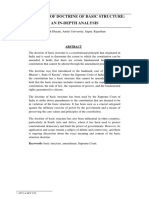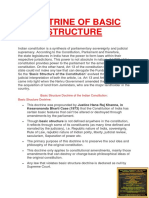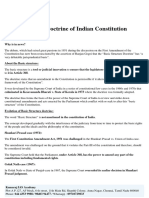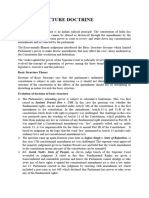0% found this document useful (0 votes)
29 views6 pagesComponents of The Basic Structure
The document outlines the components of the Basic Structure Doctrine in Indian constitutional law, emphasizing the supremacy of the Constitution, the republican and democratic form of government, secularism, federal structure, separation of powers, and judicial review. It discusses key court cases that shaped the doctrine, including the landmark Kesavananda Bharati case, which established that Parliament cannot alter the Constitution's basic structure. The document also addresses criticisms of the doctrine and its significance in preserving constitutional ideals and protecting fundamental rights.
Uploaded by
Yash RajCopyright
© © All Rights Reserved
We take content rights seriously. If you suspect this is your content, claim it here.
Available Formats
Download as PDF, TXT or read online on Scribd
0% found this document useful (0 votes)
29 views6 pagesComponents of The Basic Structure
The document outlines the components of the Basic Structure Doctrine in Indian constitutional law, emphasizing the supremacy of the Constitution, the republican and democratic form of government, secularism, federal structure, separation of powers, and judicial review. It discusses key court cases that shaped the doctrine, including the landmark Kesavananda Bharati case, which established that Parliament cannot alter the Constitution's basic structure. The document also addresses criticisms of the doctrine and its significance in preserving constitutional ideals and protecting fundamental rights.
Uploaded by
Yash RajCopyright
© © All Rights Reserved
We take content rights seriously. If you suspect this is your content, claim it here.
Available Formats
Download as PDF, TXT or read online on Scribd
/ 6




























































































